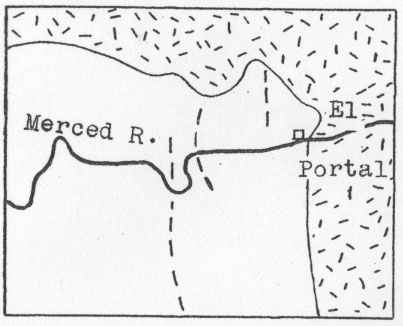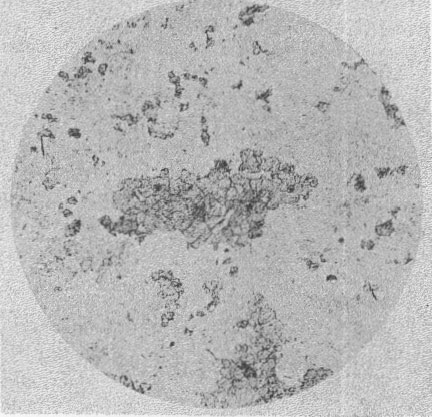
|
|
Volume 16, pages 461-468, 1931
BARITE AND WITHERITE FROM NEAR EL PORTAL, MARIPOSA COUNTY, CALIFORNIA A. A. FITCH CONTENTS
LOCATION.................................... 461 LOCATION The deposits to be described comprise a group of north-south veins outcropping on both sides of the Merced River (though more abundant to the south), near El Portal, the entrance to Yosemite National Park on the All-Year Highway. They have been traced for a mile to the north of the Merced River, and two miles to the south, while isolated exposures have been found much further afield.
The property is worked by the National Pigments Company, who produce about seventy tons daily. It was discovered and first mined in the eighties; the Yosemite Barium Company acquired the property in 1927, and disposed of it to the present owners. The method of mining and milling has been described by Young.1 GENERAL GEOLOGY The area in which the veins occur is on the western flank of the Sierra Nevada batholith, and consists of isoclinally folded sediments, dominantly argillaceous, but with some arenaceous and limestone beds. These have suffered a low-grade dynamic metamorphism, superimposed upon which is a more localized chemical and thermal metamorphism, centered around small bosses of granite revealed by erosion of the roof of the batholith. The age of the sediments is not known more precisely than that they are Palaeozoic, and the granite supposedly late Jurassic. Biotite-hornblende granodiorite is the major rock type of the boss in association with which the deposits occur: a more basic phase, a hornblende-diorite, occurs marginally and as autoliths in the granodiorite. The veins, which vary in width up to twenty feet, dip and strike in conformity with the enclosing sediments, and all of them terminate at the margin of the granite boss. As the bosses are approached, the vein-filling changes completely in composition and texture. VEIN FILLING BARITE. Barite occurs as an equigranular aggregate, the grade-size varying from one band to another, 0.1-0.5 mm. This banding lies parallel to the walls of the vein, and in occasional sections the barite grains are slightly elongated in that direction. The finer-grained bands are generally the more impure, in that they may often contain an abundance of: a. Rounded quartz individuals. b. Cubes of pyrite. c. Wedge-shaped crystals of titanite. d. Prisms and grains of tourmaline. e. Magnetite dust. f. Flakes of chlorite. Scattered through the mass of the barite, without regard for the grade size of particular bands, are: a. Euhedral, prismatic crystals of a pyroxene near hedenbergite, which are commonly altered in an obscure fashion to an opaque mat. b. Ragged prisms of actinolite. c. Witherite, occurring as interstitial, irregular stringers: clearly soluted residual fragments of large individuals. Ore of this type forms much of the vein material in the parts distant from the granite. So-called "horses" occurring in the ore are either of fine-grained barite, or masses of quartz-pyrite rock. WITHERITE. Witherite occurs, as does the barite, in equigranular aggregates, about 1 mm. in grade size. It is found in restricted parts of the veins lying nearer to the granite than most of the barite, but to some extent it is intermixed with that mineral. Its associated impurities are similar to those found in the barite, and do not call for further comment, except to remark that where barite occurs, it may be locally a replacement of witherite. In thin section, witherite is discriminated from calcite by its less perfect cleavage, extinction parallel with the best cleavage direction, the very marked change of relief on rotating the lower Nicol, and by its twinning. Witherite exhibits the usual cyclic twinning on m [110], whereby pseudohexagonal groups are produced: the angle m: m' is 118° 30'. In addition, each individual shows polysynthetic twinning, the laminae in the three individuals of the cyclic twin making angles of approximately 120° with each other. This twinning law cannot be determined precisely from the sections available, but the twin and composition plane is apparently a face in the c-zone, and since both pinacoids are planes of symmetry, it follows that the twin plane is a prism. Further, since the laminae in adjacent individuals of the cyclic twin do not extinguish together, the twin plane for the polysynthetic twinning is different from that for the cyclic twinning, i.e., the twin-plane for the polysynthetic twinning is a prism other than [110]. In witherite, twinning is only conspicuous in sections perpendicular to the common c-axis, such sections showing very low birefringence, about 0.001. This is in marked contrast with the polysynthetic twinning of calcite, appearing in sections of widely differing orientations and birefringence. CALC-SILICATE MINERALS. As the veins are followed toward the granite boss, there is a development of increasingly coarse calc-silicate minerals, and a corresponding diminution and finally a complete absence of barite and witherite. The calc-silicate minerals observed are:
Andradite Other minerals occurring in smaller quantity are:
Quartz The calc-silicate rock is roughly banded parallel with its walls, and the bands may differ widely in composition. Bands having the following constitution have been noted: a. Calcite b. Quartz c. Euhedral or subhedral andradite porphyroblasts in a granular quartz matrix: a partial intergrowth of the two minerals may occur. d. Small hedenbergite idioblasts in a granular quartz matrix. e. Hedenbergite glomeroblasts2 in a granular anorthite matrix. f. Finely granular almost hornfelsic aggregate of hedenbergite and clinozoisite, with interstitial residual calcite. g. Euhedral or subhedral andradite, and euhedral vesuvianite porphyroblasts in a quartz matrix. h. Vesuvianite idioblasts in a quartz matrix. Occurring in parallel growth with the hedenbergite are occasional thin prisms of a peculiar sodic amphibole, pleochroic in blue and green, with Z Λ c at least 22°, but sufficient material was not available for precise identification. Cutting the glomeroblasts and isolated porphyroblasts of hedenbergite are ragged crystals of actinolite, growing at the expense of the hedenbergite, a change involving partial replacement of lime by iron oxide and magnesia. The hedenbergite, however, has an unusually deep green color, and it may possibly contain more iron than is indicated by the formula CaO • Fe2O3 • 2SiO2. If this be assumed, the change to actinolite, CaO • 3(Fe,Mg)O • 4SiO2, becomes almost a simple paramorphism. Certainly there is no petrological evidence of addition or subtraction of material during the change. SURFICIAL PRODUCTS The calc-silicate minerals are little affected by the action of meteoric waters. Barite, also, is unchanged, though a small amount of redistribution and recrystallization has taken place. When the witherite-pyrite-quartz ores are subjected to the action of meteoric waters, the pyrite first oxidizes and hydrates to limonite, with the production of sulphuric acid. 4FeS2+15O2+8H2O=2Fe2O3+8H2SO4 The sulphuric acid then attacks the witherite with production of barite
BaCO3+H2SO4= BaSO4+H2O+CO2 Hence there result two kinds of product from this surficial oxidation and hydration: a. An earthy aggregate of limonite and finely crystalline barite in small tabular crystals. b. Barium sulphate has sometimes migrated from its place of origin, and produced stalactitic clusters of barite crystals. It is possible that it was calcium sulphate which was first formed by reactions with calcite similar to those outlined above for witherite, and that the calcium salt migrated and reacted with witherite to produce the barite found in stalactites. As the barite crystals in this surficial material increase in size, they show a peculiar change of habit. a. Microscopic crystals, about 0.1 mm. in diameter, are flat and tabular with [001] and [110]. b. The smaller macroscopic crystals, of 1 or 2 mm. diameter, are equidimensional with the same faces. c. Crystals of larger size, up to 2 cms. in diameter, reveal an increasing tendency to round off the obtuse angle between the prism faces, and to have irregular stepped faces. WALL ROCKS It has already been noted that the wall rocks of the vein consist everywhere of metamorphosed sediments, and that the veins no where cut the granite.
Two types of argillaceous wall rocks may be recognized: At considerable distances from the granite boss, the wall rocks have suffered but a mild dynamic metamorphism, and are calcareous or graphitic slates. However, as the granite is approached, the calcareous slate is converted to a quartz-biotite hornfels, banded with quartz, and then passes through various stages of contortion, finally becoming a homogeneous, highly siliceous hornfels. Concomitantly, the graphitic slate develops spots which become progressively larger until they are recognizable as distinct chiastolite individuals and they in turn increase in size as the contact is approached. Close to the contact, however, the chiastolite breaks down, yielding a mica-schist with predominant muscovite. GENESIS The evidence presented in the foregoing sections all indicates that the deposits are formed by replacement of a bed of limestone by barium solutions given off from the underlying Sierra Nevada granite batholith. The palimpsest features pointing to replacement are summarized below. PETROLOGICAL. a. Relics of bedding. b. Relics of detrital mineral grains in the ore: tourmaline, sericite and titanite. c. The presence of calc-silicate minerals in the ore. d. The lateral gradation into calc-silicate rocks. One specimen was obtained which shows very clearly the course of the mineralization. It is a crystalline limestone, in which the calc-silicate stage is represented by the growth of rounded quartz individuals and hedenbergite idioblasts. The remaining calcite has been replaced successively by witherite and barite. This one specimen epitomizes the history of the deposit, which may be stated thus:
a. Hypothermal.
b. Mesothermal.
c. Surficial. It is interesting to note that the granites from this province may carry rather high percentages of barium: thus one from Agua Fria Creek carries 0.10% (quoted by Washington, Chemical Analyses of Igneous Rocks, pp. 228-9). A specimen of granite near the contact on the strike of the lode gave only a trace of barium, which suggests that the deposits, though near the contact, arise from a more deep-seated source within the batholith. STRUCTURAL It was the structural evidence that gave the first clues in the field to the mode of origin of the deposit. Thus the veins nowhere transgress the strike of the isoclinally folded beds; the dip of the veins is high (usually about 80°) according with the dip of the enclosing rocks. In one case, a little south of the Merced River, the vein has been traced downwards to the bottom of one of the isoclinal folds, where it turns sharply upwards, and is soon pinched out. METAMORPHIC ZONES It is possible to correlate the nature of the vein filling with the degree of contact metamorphism of the two types of slate constituting the wall rocks, as shown in the following table. The distances given refer to the vein forming the core of the ridge running north-south a little to the east of the mill.
SUMMARY A group of barite-witherite veins is described, which have arisen by replacement of a bed of limestone constituting part of an isoclinally folded series of Palaeozoic sediments. All gradations are found in these limestone bands from pure barite or witherite to coarse andradite-hedenbergite and other calc-silicate rocks as the margin of a small granite boss is approached.
NOTES 1 Young, G. J., Mining and Milling Barite: Eng. and Min. Journ. Press, Vol. 130, p. 70, 1930. 2 The term 'glomeroblast' is adopted here for convenience of description of a fairly common contact metamorphic rock texture for which no adequate term exists. A 'glomeroblast' is defined as a porphyroblast, in which the unit is not a single individual, but an aggregate of grains. 'Glomeroblastic' is thus a metamorphic rock texture corresponding to the glomeroporphyritic texture of igneous rocks in the same way as porphyroblastic corresponds with porphyritic. [var:'startyear'='1931'] [Include:'footer.htm'] |


 FIG. 3. Showing change of habit with increasing size of barite crystals.
FIG. 3. Showing change of habit with increasing size of barite crystals.